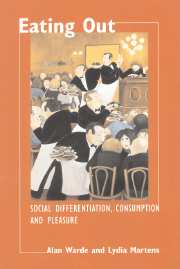Book contents
- Frontmatter
- Contents
- List of illustrations
- List of tables
- Acknowledgements
- 1 Studying eating out
- Part I Modes of provision
- 2 The development of the habit of eating out in the UK
- 3 The meanings of eating out
- Part II Access
- Part III Delivery
- Part IV Enjoyment: the attractions of eating out
- Part V Conclusion
- Methodological appendix: data collection and analysis
- References
- Index
3 - The meanings of eating out
Published online by Cambridge University Press: 22 September 2009
- Frontmatter
- Contents
- List of illustrations
- List of tables
- Acknowledgements
- 1 Studying eating out
- Part I Modes of provision
- 2 The development of the habit of eating out in the UK
- 3 The meanings of eating out
- Part II Access
- Part III Delivery
- Part IV Enjoyment: the attractions of eating out
- Part V Conclusion
- Methodological appendix: data collection and analysis
- References
- Index
Summary
In Feeding the Family (1991),DeVault deploys the concepts of social organisation and shared understandings in her analysis of why it is women who are recruited into the project of caring for the family.
The concept of social organization explains how women (and others) enter social relations, actively producing their own activities in relation to the activities of others. It points to the importance of shared understandings about particular settings, recognizing that these are subject to change through negotiation, disputation and improvisation, but that they are always relevant to human conduct.
(DeVault, 1991: 12)The notion of social organisation emphasises the significance of individual agency as well as the bearing of larger social relations on this activity. DeVault, who draws on Dorothy Smith's feminist methodology, suggests that the starting point of her analysis is the careful listening and interpretation of accounts of ‘everyday lived experience’, by which she means ‘what happens in people's everyday lives – as well as the processes of interpretation that give meaning to everyday lives’ (1991: 11). Individual accounts reveal something about the wider social power relations within which everyday life takes place; ‘we find that social organization is “in the talk” and that we can mine the talk for clues to social relations’ (DeVault, 1990: 101).
DeVault uses the ‘family’ as example. ‘When we speak about contemporary families’, she argues, ‘we refer to two kinds of realities, to both experience and institution’ (1991: 14). People experience ‘family’ in diverse ways.
- Type
- Chapter
- Information
- Eating OutSocial Differentiation, Consumption and Pleasure, pp. 42 - 64Publisher: Cambridge University PressPrint publication year: 2000



